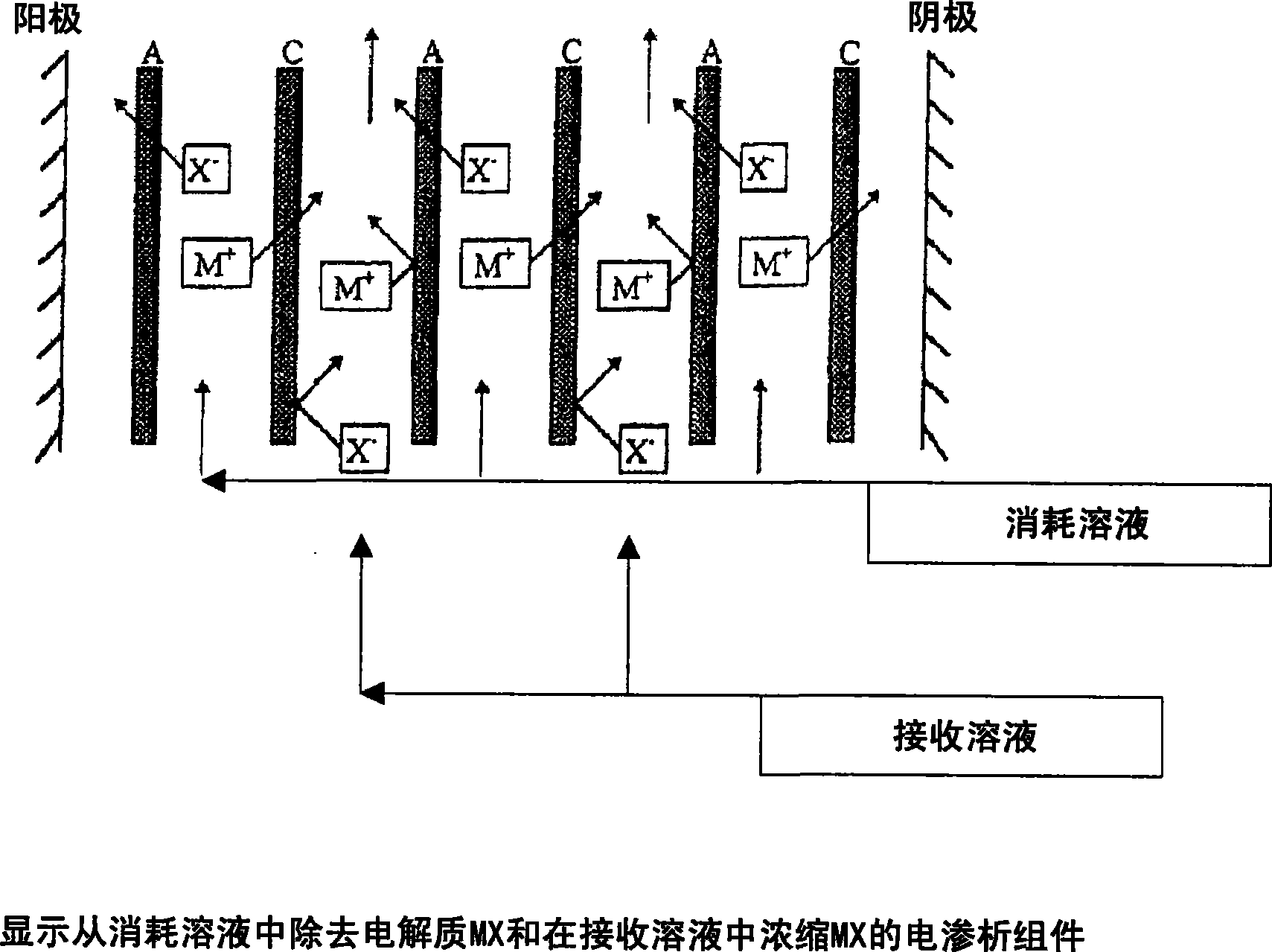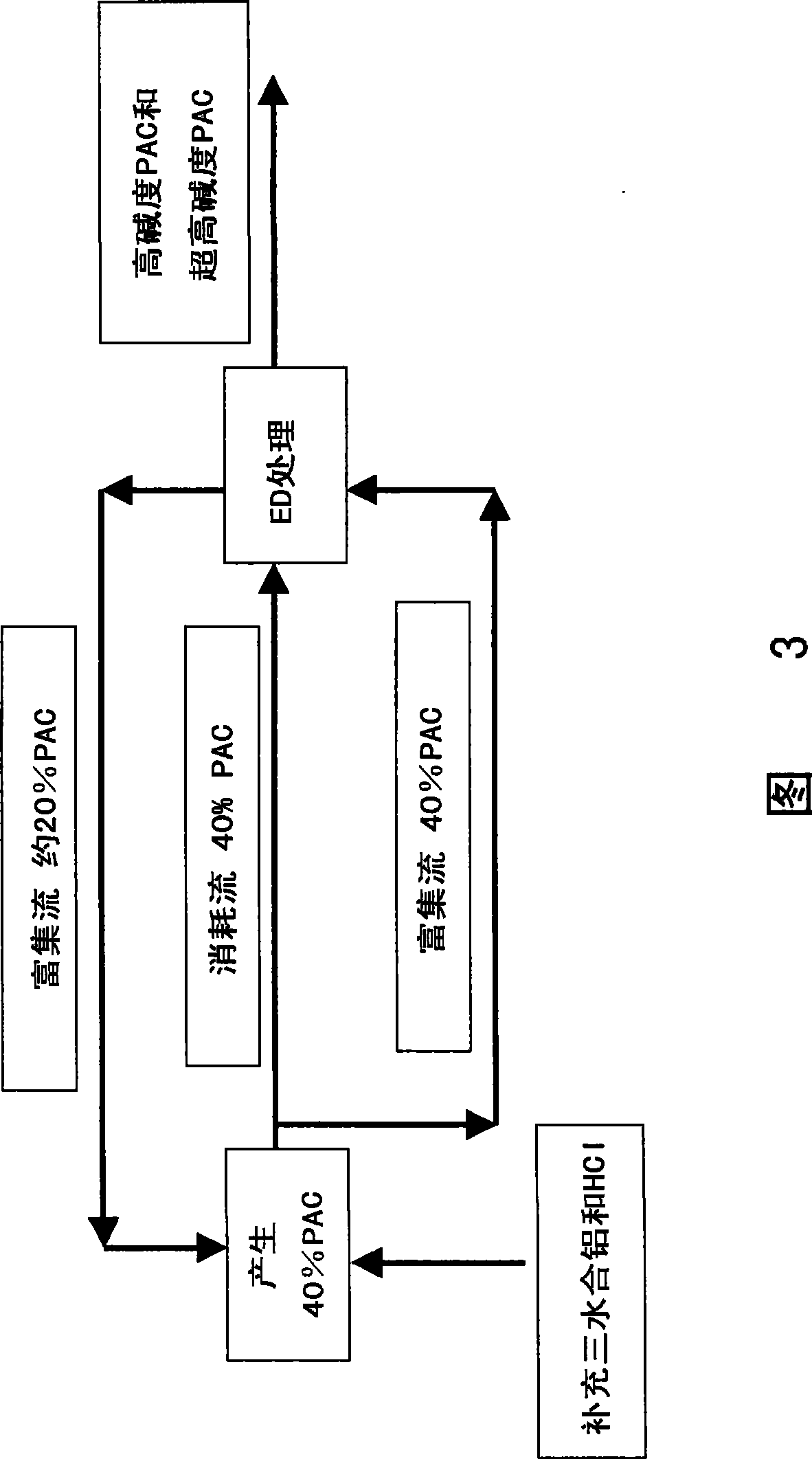Polyaluminum chloride and aluminum chlorohydrate, processes and compositions: high-basicity and ultra high-basicity products
A technology of general formula and product, applied in the field of producing high basicity polyaluminum chloride and basic aluminum chloride, can solve the problems of powder explosion, highly turbid batch materials, poor predictability, etc.
- Summary
- Abstract
- Description
- Claims
- Application Information
AI Technical Summary
Problems solved by technology
Method used
Image
Examples
Embodiment 1
[0128] Embodiment 1: produce high alkalinity PAC
[0129] Electrodialysis module: Eurodia 6 (20 membrane pairs)
[0130] Temperature 60°C
[0131] Membranes: Neosepta CMX and ASM
[0132] Raw materials: 40% PAC, Holland Chemical PACL-300
[0133] Consumption: 40% PAC
[0134] Enrichment solution: CaCl 2
[0135] Dilute 50 L of 40% PAC with 50 L of deionized water. The solution was stirred and heated to 90°C. The solution was kept at this temperature for 1 hour and then topped up with distilled water back to a total volume of 100 liters (to make up for evaporation losses). After cooling to 60° C., the resulting solution was fed to the electrodialysis module as the above-mentioned depleting solution.
[0136] The enrichment solution is 2M CaCl 2 solution (10 L). The enrichment solution compartment is equipped with a supply of Ca(OH) 2 Equipment added to maintain pH equal to or greater than 0.5 during operation. The spent solution was heated to 60°C and maintained at ...
Embodiment 2
[0139] Embodiment 2: produce ultra-high alkalinity PAC
[0140] Electrodialysis module: Eurodia 6 (20 membrane pairs)
[0141] Temperature 60°C
[0142] Membranes: Neosepta CMX and ASM
[0143] raw material:
[0144] Depletion solution: 70% PAC from Example 1
[0145] Enrichment solution: 40% PAC (diluted 1:1 with water)
[0146] Dilute 58 liters of 70% PAC (15.4% Al 2 o 3 ); the stirred solution was heated to 90°C. The solution was maintained at this temperature for 1 hour, then cooled to 60°C, and the resulting solution was then fed to the electrodialysis module as the depleted solution described below.
[0147] In this example, the enrichment solution was obtained by diluting 23.5 liters of 40% PAC with 3 liters of water.
[0148] The enrichment and depletion solutions were cycled and a potential gradient of 22 volts was applied to the cell (approximately 0.8 volts / membrane pair). Initial current limited to 50mA / cm 2 . This voltage was maintained for the remainde...
Embodiment 3
[0151] Embodiment 3: produce ultra-high alkalinity PAC
[0152] Electrodialysis module: Eurodia 6 (15 membrane pairs)
[0153] Temperature 55°C
[0154] Membranes: Neosepta CMX and AHA
[0155] raw material:
[0156] Depletion solution: 70.4% PAC (15.9% Al 2 o 3 )
[0157] Enrichment solution: 70.4% PAC (15.9% Al 2 o 3 )
[0158] In this example, for 21 liters of 70.4% (15.9% Al 2 o 3 ) Alkalinity of the PAC heat treatment. This heat treatment step consisted of heating the stirred PAC solution to 90°C and maintaining this temperature for 1 hour. After cooling to a temperature of 55° C., 14.7 liters of this solution were added to the consuming solution container in the ED module; 6.3 liters of this solution were added to the receiving solution container in the ED module. Applying 18 volts to the electrodes starts a cycle of consuming solution and receiving solution. The initial current density is 50 mA / cm 2 . The run was terminated after passing through 22.4 mole...
PUM
| Property | Measurement | Unit |
|---|---|---|
| current efficiency | aaaaa | aaaaa |
| current efficiency | aaaaa | aaaaa |
| current efficiency | aaaaa | aaaaa |
Abstract
Description
Claims
Application Information
 Login to View More
Login to View More - R&D
- Intellectual Property
- Life Sciences
- Materials
- Tech Scout
- Unparalleled Data Quality
- Higher Quality Content
- 60% Fewer Hallucinations
Browse by: Latest US Patents, China's latest patents, Technical Efficacy Thesaurus, Application Domain, Technology Topic, Popular Technical Reports.
© 2025 PatSnap. All rights reserved.Legal|Privacy policy|Modern Slavery Act Transparency Statement|Sitemap|About US| Contact US: help@patsnap.com



